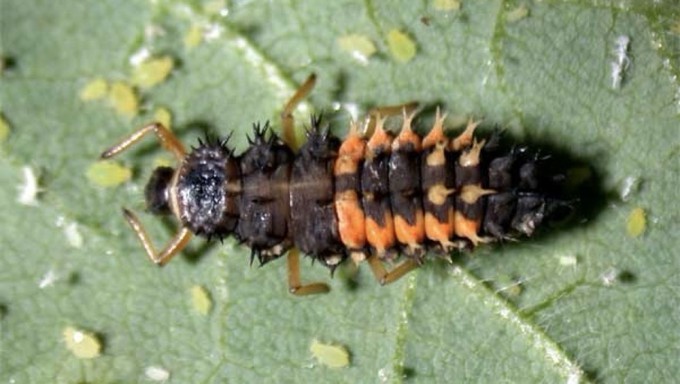
Yolo County master gardeners offer free online workshop on insect, disease identification

Lady beetle larvae like this one are scary looking, but they're voracious eaters of aphids. Courtesy University of Wisconsin
Is that a good guy or a bad guy? That’s my first thought when I see an unfamiliar bug in my garden.
Some good guys – such as lady beetle larvae – look pretty scary, while some beauties bring trouble. (For example, the five-spotted hawk moth starts out as a tomato hornworm.)
Learn how to tell the difference between good and bad bugs as well as how to identify common plant diseases during a free Zoom workshop, presented by the UCCE master gardeners of Yolo County.
Set for 3 p.m. Thursday, Jan. 11, “The Good, The Bad and The Ugly: Insects and Diseases Every Gardener Should Know” will help gardeners throughout the greater Sacramento area better identify what’s bugging their plants – especially in the vegetable garden.
“Experienced Yolo County Master Gardener Mike Kluk will lead the discussion, which will cover a variety of insects commonly found in the garden, both beneficials and bad guys, and common diseases,” say the master gardeners. “The emphasis will be on insects and diseases that have the most impact on vegetable gardens, although most of the information will be relevant to ornamentals as well.”
This one-hour seminar is immediately practical. For example, what’s eating your cabbage? More than 20 different kinds of bugs could be the culprits (plus some mammals, too). Find out how to spot tell-tale signs.
Proper identification of pests and diseases is key to treatment, control and prevention, note the master gardeners. By being able to tell the good bugs from the bad ones, gardeners can support beneficial insects that help their plants while effectively containing pest infestations with little or no chemicals.
No advance registration is necessary; just Zoom on in. Here’s the Zoom link: https://ucanr.zoom.us/j/98806256671.
Details and more information on Yolo County master gardeners: https://yolomg.ucanr.edu/.
Comments
0 comments have been posted.Sacramento Digs Gardening to your inbox.
Food in My Back Yard Series
April 29: What's (already) wrong with my tomato plants?
April 22: Should you stock up on fertilizer? (Yes!)
April 15: Grow culinary herbs in containers
April 8: When to plant summer vegetables
April 1: Don't be fooled by these garden myths
March 25: Fertilizer tips: How to 'feed' your vegetables for healthy growth
March 18: Time to give vegetable seedlings some more space
March 11: Ways to win the fight against weeds
March 4: Potatoes from the garden
Feb. 25: Plant a fruit tree now -- for later
Feb. 18: How to squeeze more food into less space
Feb. 11: When to plant? Consider staggering your transplants
Feb. 4: Starting in seed starting
Sites We Like
Garden Checklist for week of May 4
Enjoy this spring weather – and get gardening!
* Plant, plant, plant! It’s prime planting season in the Sacramento area. Time to set out those tomato transplants along with peppers and eggplants. Pinch off any flowers on new transplants to make them concentrate on establishing roots instead of setting premature fruit.
* Direct-seed melons, cucumbers, summer squash, corn, radishes, pumpkins and annual herbs such as basil.
* Harvest cabbage, lettuce, peas and green onions.
* In the flower garden, direct-seed sunflowers, cosmos, salvia, zinnias, marigolds, celosia and asters. (You also can transplant seedlings for many of the same flowers.)
* Plant dahlia tubers. Other perennials to set out include verbena, coreopsis, coneflower and astilbe.
* Transplant petunias, marigolds and perennial flowers such as astilbe, columbine, coneflowers, coreopsis, dahlias, rudbeckia and verbena.
* Keep an eye out for slugs, snails, earwigs and aphids that want to dine on tender new growth.
* Feed summer bloomers with a balanced fertilizer.
* For continued bloom, cut off spent flowers on roses as well as other flowering plants.
* Add mulch to the garden to maintain moisture. Mulch also cuts down on weeds. But don’t let it mound around the stems or trunks of trees or shrubs. Leave about a 6-inch to 1-foot circle to avoid crown rot or other problems.